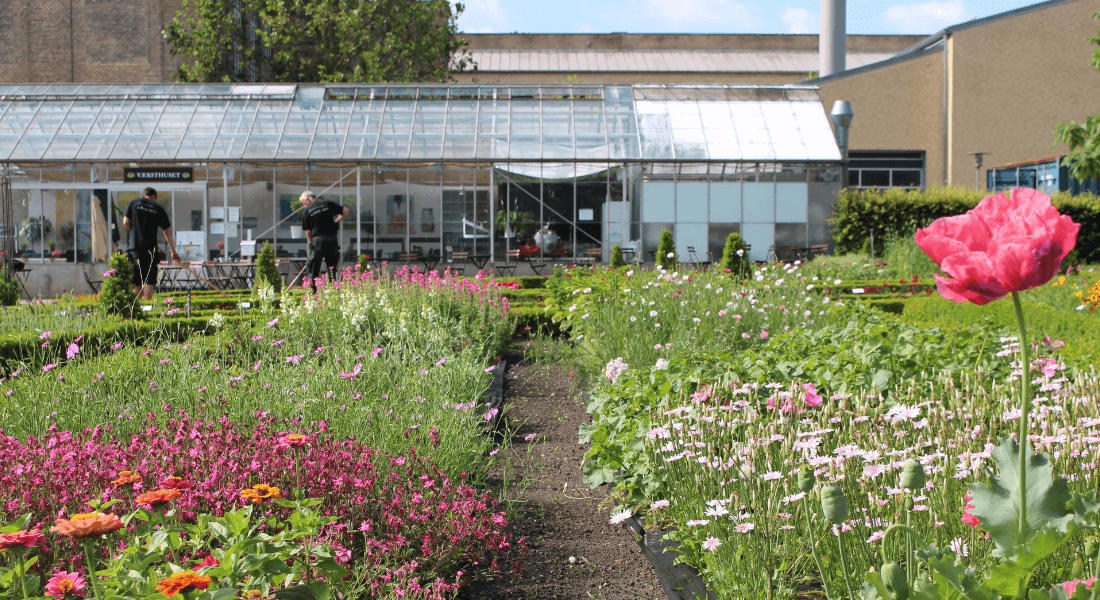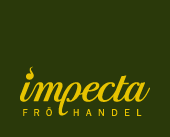Gardens - Landbohøjskolens Have
In the garden, plants are grown, and seeds are stored to support teaching and research at the University of Copenhagen. The garden was established in 1858 and is now part of the University of Copenhagen.
The purpose of the garden is to serve as a study garden and university park, to supply plants for teaching, and to be a green oasis for everyone. Take a walk through the unique historical surroundings and experience more than 6,000 different plants!
Read more about the University Gardens at Frederiksberg (in Danish).
About the Garden
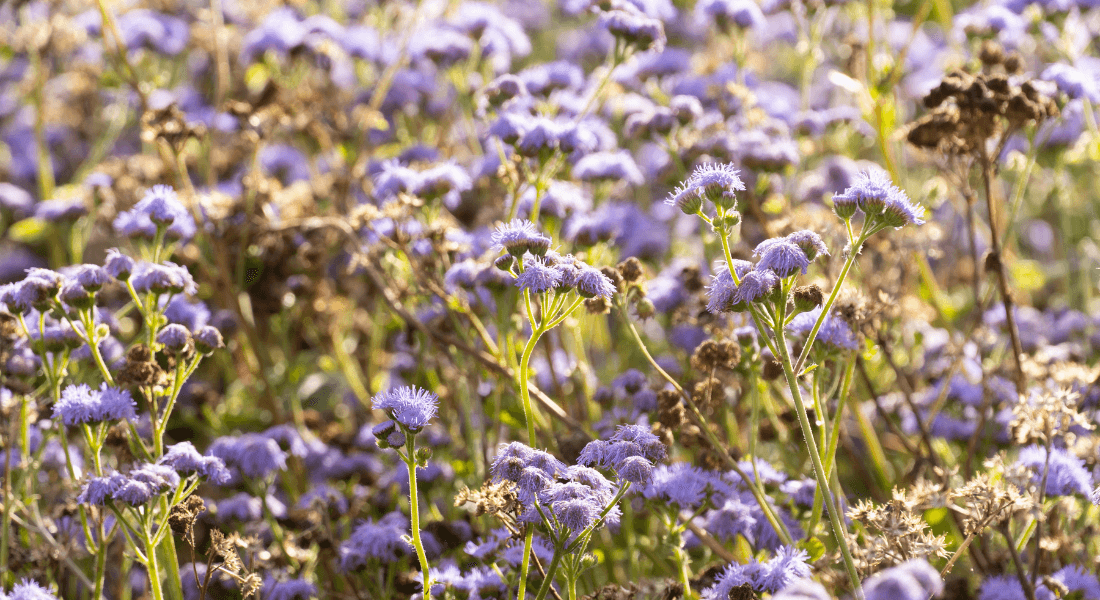
The garden started from bare fields far away from Copenhagen, and a garden was designed that, to this day, is a great attraction for both faculty staff and students as well as garden enthusiasts from the neighborhood and visitors from afar. The garden was named Landbohøjskolens Have.
Today, there are several gardens in the area, and both the gardens and all the green spaces surrounding the buildings at Frederiksberg Campus are collectively known as Landbohøjskolens Have. The campus area stretches from Grundtvigsvej in the west to Ågade in the east, and is bordered by Bülowsvej to the south and Den Grønne Sti to the north.
Landbohøjskolens Have was laid out in the romantic style of the time, with many elements from landscape gardens. The garden contains many of the garden and park spaces typical of this style: a pond, a stream, a rock hill, a rose garden, a forest, groves and open areas, carpet beds, flower beds, etc. Today, the central part of the garden is called The Romantic Garden.
In 1856, the state purchased the Rolighed estate, and on this property, far out in the countryside, the construction of Landbohøjskolen’s first buildings began, with Bindesbøll’s main building and the southern and northern wings.
The old Veterinary School from 1773 in Christianshavn, where only veterinary medicine was taught, moved to Frederiksberg. However, in addition to this, the new Landbohøjskolen was to provide education to farmers, land surveyors, horticulturists, and foresters.
It was therefore a given that there should be a garden surrounding the school buildings, and with the first director of Landbohøjskolen, Councillor of State Carl Emil Fenger, as chairman, a committee was established to create a proposal for the garden's layout and use.
The garden was to fulfill three main purposes, which it still does to this day:
- Provide plant material for teaching botany and plant cultivation,
- Serve to beautify the surroundings of the educational institution, and
- Serve as a public park.
The historical information below is an excerpt from information collected by former senior gardener Kim Greiner.
The Beginning
Landbohøjskolens Garden was established in the mid-1800s, designed by Julius August Bentzien. Work on the garden began in 1858, when shrubs and trees were planted with help from several botanical experts. The garden was almost fully planted by 1860, and many of the original trees and shrubs still stand today.
The Creation
The garden was designed with romantic, winding paths and new views at every turn. Areas such as the central pond and the curved lawns with flower beds remain almost unchanged.
The Changes
Over the years, the garden has undergone changes, particularly due to the expansion of buildings. In 1922, part of the area was repurchased and used for new plant collections, and a rose garden was established in 1929.
The Gardener’s Residence
In 1919, the Gardener’s Residence was built to replace the old sheds with outhouses for the garden staff. The beautiful house, which once housed the head gardener, now functions as offices for the Department of Veterinary Disease Biology, guest rooms for international students, and offices for the garden staff. In the basement, there is a small workshop, storage for various materials, and wintering facilities for bulbs and tubers.
The Garden’s Management
The garden’s management has evolved over time. From 1858, operations were divided among several managers, which later led to a series of disagreements, prompting the creation of a garden committee in 1892. However, it was dissolved in 1903, and since then, responsibility has shifted between various leaders. Today, many planning and registration tasks are assigned to the gardeners, and work is mainly managed and distributed by self-managing teams.
The Garden Workers
In the early years, there was only one permanent gardener, but over time, more workers and students were added, particularly when the curriculum was expanded in 1896, placing greater demands on the garden and the size of the workforce. Previously, there were many "Madams" and weeding women working during the summer—today, there are usually three summer weeders covering the areas from May to September.
Today's Staff
Today, five permanent gardeners are responsible for the university gardens, including the Romantic Garden on Bülowsvej, the Summer Flower Garden, the High-Rise Area, and the Rolighedsvej Area, along with all plant collections and other green areas associated with the faculty. The garden has undergone many changes but remains an important part of the university’s grounds.
Gardener Apprentices
In 1878, H.J. Hansen became the garden’s first gardener apprentice, and in 1939, the number peaked at 14 apprentices. A curiosity was Miss Johansen, the first female apprentice in 1905. Today, there are only five gardener apprentices left.
The Garden Attendant
The garden attendant, who used to supervise and open and close the garden, has been replaced by garden guards. In the mid-1990s, the position was abolished, and now gardeners and students participate in monitoring the garden.
Regulations and the Public
Originally, the garden was only for study and strolls, and it was forbidden to step on the grass. However, since 2005, people have been allowed to use most of the lawns. The tradition of closing the garden in the evening has also ceased; now, the garden is open from sunrise to sunset.
In the old days, Landbohøjskolens Garden was a destination for Copenhageners dressed in their finest Sunday clothes, and today both locals and students visit the garden daily.
Merger with the University of Copenhagen
Since 1858, the Royal Veterinary and Agricultural University was an independent university, but from January 1, 2007, Landbohøjskolen was merged with the Danish Pharmaceutical University and the University of Copenhagen. Despite the changes, the garden continues unchanged and is still enjoyed by staff, students, and visitors.
Source: A. Pedersen: The Royal Veterinary and Agricultural University’s Horticultural Department and the University Gardens Through 100 Years, from 1964. Various small writings and personal notes.
The Goals for the University Gardens at Frederiksberg are...
- to support teaching and research at the Faculty of Science
Through providing material for teaching and research (whole plants, plant material, seed, insects, pests and benificial animals, plant ailments etc. ) and through use of the gardens for field studies in teaching. - to be a green meeting place for students, staff and visitors
Through maintaining the structure and contents of the gardens to form a green context for study and work while inviting to relaxation and contemplation. - to maintain the historic essence of the gardens and foster contemporary design for future developments
Through maintenance and replanting appropriate to the given historic context while capitalising on the opportunities for future developments offered by the Campus Plan. - to awaken interest in research and teaching at the Faculty of Science
Through the conscious display and presentation of plants in the form that serves teaching and research and thereby clearly signaling the special nature of the gardens. - to be an inspiring green idea bank locally, nationally and internationally
Through constantly developing and updating plantings and the plant collection so as to display new as well as classic plants, methods and technology of interest to professionals and amateurs alike.
Visiting the Garden
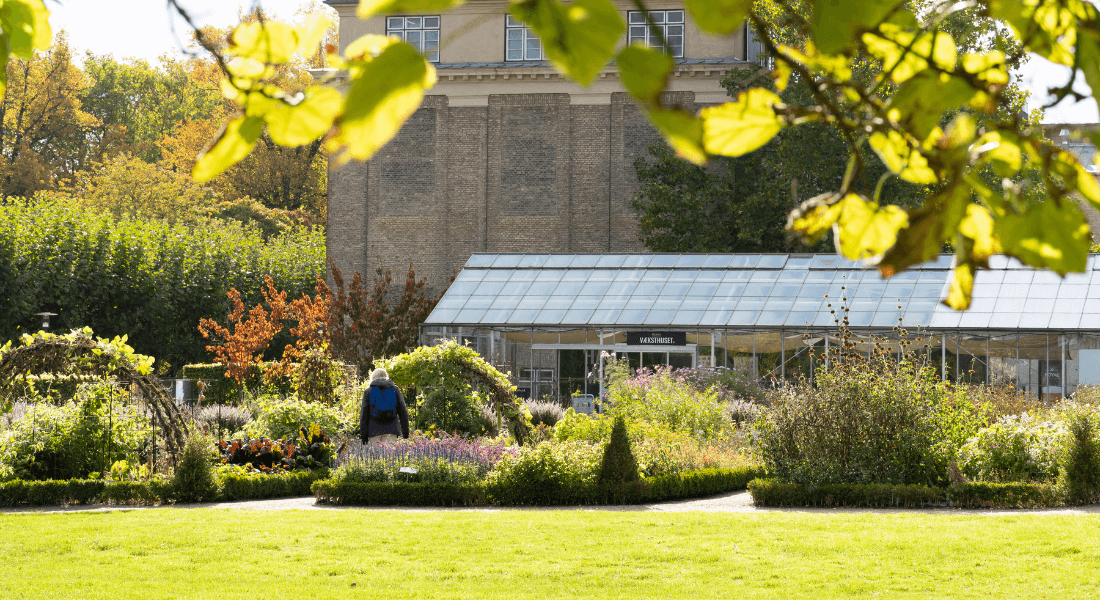
The Gardens are open from sunrise to sunset all year round, except on December 24th and 31st. If the garden is locked, the exit at Bülowsvej/Thorvaldsensvej can be used.
In case of storms, snow, icy conditions, or other risks, the garden will be closed to visitors.
Restrooms are available at the entrance from Thorvaldsensvej
 We need your help to take care of our old trees and many plants! You can help by…
We need your help to take care of our old trees and many plants! You can help by…
- Not bringing dogs or other animals
- Avoiding ball games and play (instead, we refer you to the Grønnegårdsplænen, located to the left of the garden's southwestern exit)
- Not climbing trees
- Not picking or collecting plants
- Not riding bikes, scooters, or mopeds, and not parking them in the garden
- Avoiding noise or music that may disturb other visitors in the garden
- Not using grills or open flames
- Not using pavilions, tents, garden furniture, or parasols
- Being cautious in windy weather – the garden's trees are old, and large branches may fall.
Why can't I walk my dog in the garden?
Although dogs are wonderful, they are unfortunately not welcome in the garden. There are several reasons for this, including the fact that dogs tend to dig and scratch in places where we don’t need digging. Our hardworking gardeners would also like to avoid dealing with dog waste, and most importantly, dog urine is toxic to our plants. We hope for your understanding and that you leave your dog at home the next time you visit the garden.
However, you are welcome to bring your dog on a leash in other publicly accessible areas of our faculty.
Private Events
You are welcome to hold a gathering in the garden with blankets, picnic baskets, etc., but if your group consists of more than 20 people, please contact us in advance to make arrangements.
Weddings
If you wish to get married in Landbohøjskolen Garden, you are welcome to do so if the bride or groom is a current or former employee/student at the University of Copenhagen in Frederiksberg. Please contact us so we can inform you about available times in the garden.
Filming and Photography
Contact us if you wish to use the garden for filming or photography for commercial purposes. Photographs for private use, such as wedding pictures, do not require prior arrangements.
The Collections
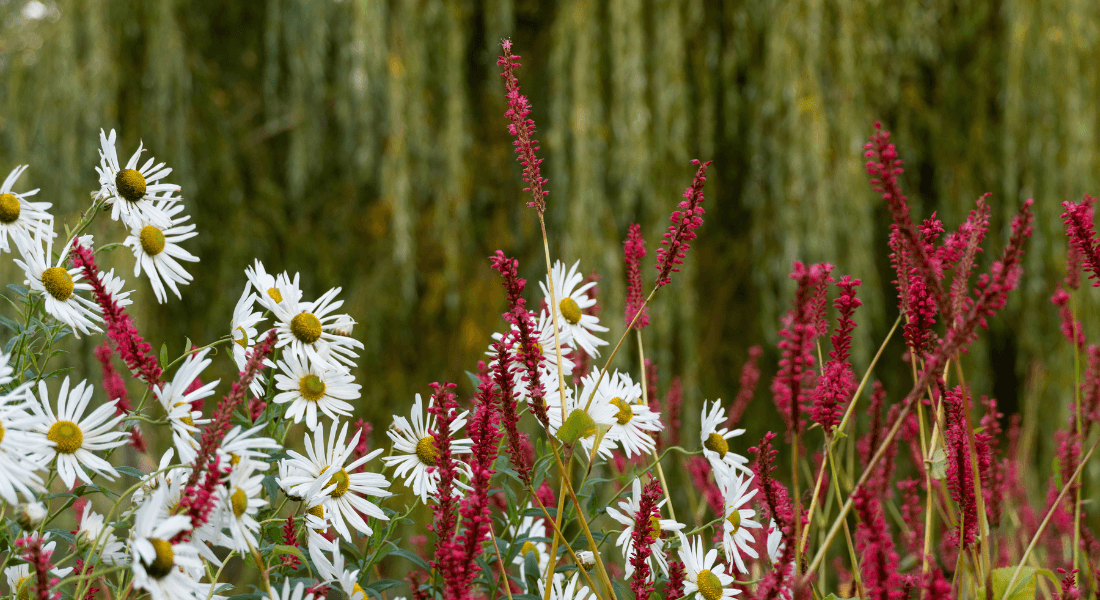
The Gardens contain a large and diverse collection of cultivated and wild plants. Unlike the Botanical Garden, our focus is on cultivated species and cultivars.There are around 6,000 different plants (species, cultivars, hybrids, etc.) in our Gardens. There are collections of wild Danish herbs and woody plants, as well as collections of plants with cultivars and cultivated plants, with a focus on ornamental and practical value. The collections are primarily used for teaching students and for research.
In the Gardens, there are areas with special plant collections, such as the rockery with alpine plants, the rose garden with an abundance of roses, the acid beds with azaleas, rhododendrons, and heather, the shade hill with ferns and woodland plants, the perennial walk, etc. Near Café Væksthuset, there are collections of annual flowers, herbs, and medicinal plants. These collections are open to the public.
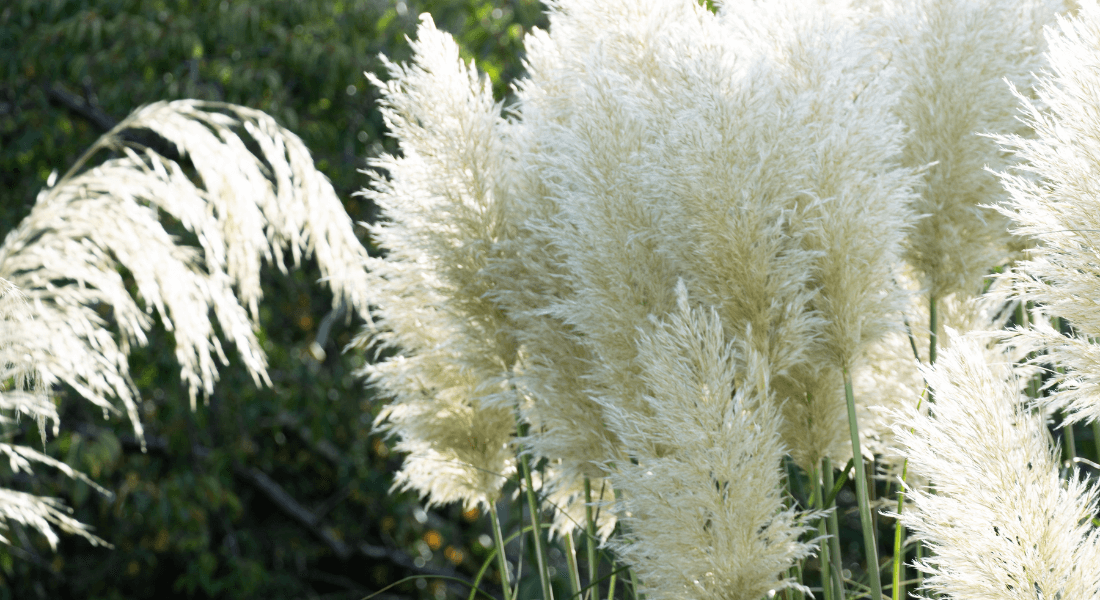
Grasses
The grass collection consists of the best grasses selected for their beauty, health, and good growing qualities.
Grasses with many underground runners or that pose a risk of spreading are therefore not represented in the grass collection.
To highlight the grasses, various groundcover plants such as foamflower and barren strawberry have been planted underneath.
Read more about the grasses and their care below.
The use of grasses in gardens and landscapes
Grasses are especially good for small gardens, where their long, narrow leaves and sweeping flower spikes add an elegant touch all summer long and well into winter.
Note that it’s not just the giants among grasses that give the garden a stylish look, but often the smaller grasses with their distinctive leaves, leaf colors, and attractive flower spikes.
If you're interested in grasses, here you have the opportunity to closely study the individual varieties and make your choice if you want to grow grasses in your own garden.
Grasses are mainly "grass green," but can also have various shades of green, silver, white-striped, blue, yellow-striped, yellow, and reddish-brown – which is clearly visible in this grass collection.
Be aware that blue grasses, like Festuca and Agropyron, require a sunny and not too moist growing spot.
Care of grasses
Grasses should be watered and fertilized like the other plants in the garden. They are healthy and rarely attacked by pests. They require no spraying with chemicals.
The delicate grasses, such as Pampas grass (Cortaderia), should be winter-covered with leaves and fir branches.
Cutting back the dry grass stalks and leaves should be done in March-April. As a general rule, the tops should be removed before the new grass grows.
If the grass clump has grown too large, it can be divided in April-May.
Medicinal Plants
In a 'secret' corner by the gardener’s house on Grønnegårdsvej, you will find the collection of plants with medicinal uses.
These are plants that have been used throughout history, and most are still used in modern medical treatments.
Many of the plants in Landbohøjskolens Have are toxic, and particularly in this collection of medicinal plants, there are many poisonous species. Therefore, we would like to remind visitors that it is not permitted to pick or collect plants or plant parts from the collections in Landbohøjskolens Have.
Information for Researchers, Educators and Professionals

Cutting Service
The Gardens and the Greenhouses maintain a wide range of plant collections with the aim of providing cut plant material for teaching botany and related subjects both at the University of Copenhagen and at other educational institutions and universities.
The Gardens and the Greenhouses supply cut plant material for teaching botany and related subjects at the University of Copenhagen and at other similar institutions and universities.
If you are subject to the user fee system, which applies to employees and students at the University of Copenhagen, you must contact us regarding ordering and payment.
Other users, such as researchers, educators, and students at other Danish or international universities, research institutions, or companies, are welcome to contact us for further arrangements regarding the delivery of plant material from our collections. We are happy to provide a quote for a complete task.
The plant collections can also be used for field teaching with small groups of students. Similarly, the collections can be used for inspiration tours for smaller groups of professionals within the green sector.
However, we kindly ask to be notified in advance so that we can account for this in our planning. The general rules of the Gardens must, of course, be followed.
Seeds from annual and perennial plants are collected for exchange with other botanical gardens and parks.
Seeds from our Index Seminum are not on sale but are available, on an exchange basis, exclusively for scientific, educational, and nature conservation purposes.
The Index Seminum list for 2021-2022 can be found here.
For inquiries regarding the Index Seminum, contact Lars Birck.
Seeds can be ordered by indicating the enclosed Desiderata or by e-mail to: haven@plen.ku.dk
Progeny raised from these seeds may not be used to generate commercial profit without prior written permission from the University Gardens, which will not be granted unless equitable sharing of benefits with the countries of wild origin, under the terms and in the spirit of the Convention on Biological Diversity, is secured.
Seeds or their progeny passed on to third parties must be vinculated to the same conditions.
Contact
The gardens
Grønnegårdsvej 15, 1. floor
DK-1870 Frederiksberg C
Teamleader: Lars Birck
Mail: haven@plen.ku.dk

